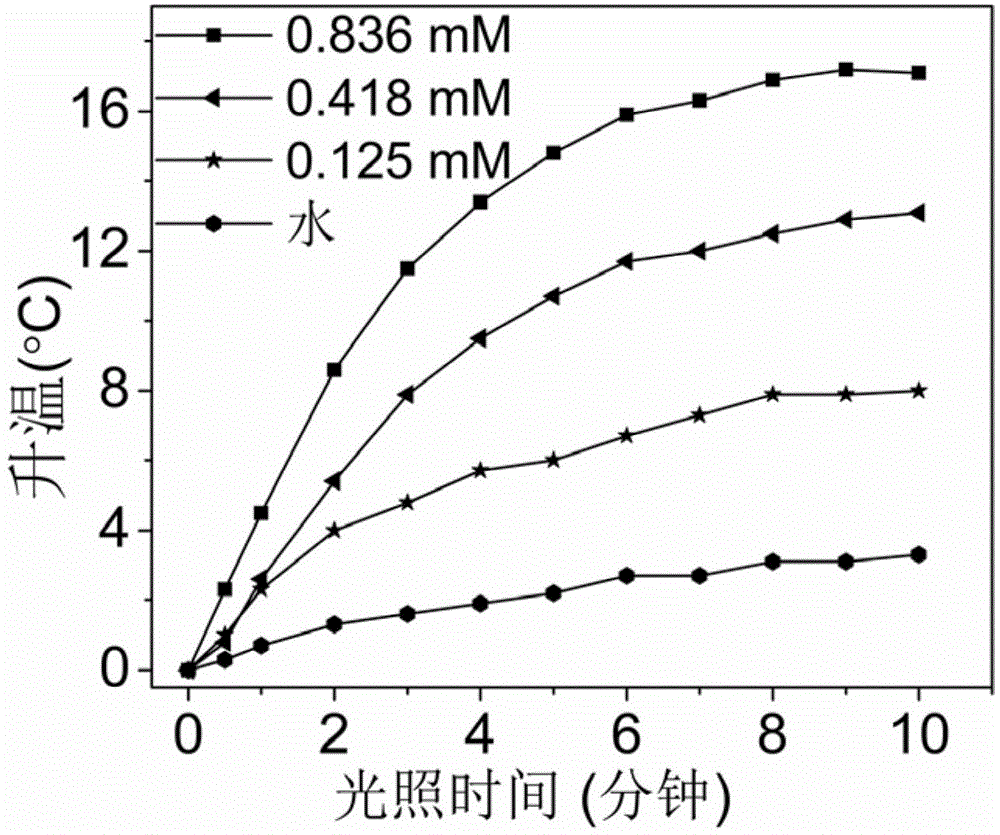Method for preparing CuS photothermal therapy nano material with good biocompatibility
A technology of biocompatibility and nanomaterials, applied in the field of preparation of CuS photothermal nanomaterials, can solve the problems of photothermal nanomaterials restricting biological applications, etc., and achieve easy large-scale popularization and application, simple reaction conditions, safe and convenient operation Effect
- Summary
- Abstract
- Description
- Claims
- Application Information
AI Technical Summary
Problems solved by technology
Method used
Image
Examples
Embodiment 1
[0017] The preparation method of CuS nanomaterials for photothermal therapy with good biocompatibility is prepared by a one-pot method, and the steps are as follows:
[0018] 1) In a 50mL round bottom flask, dissolve 250mg bovine serum albumin in 7.5mL water, add 1mL 0.2M Cu(NO 3)2 solution, after mixing, add 0.5mL 1M NaOH solution, then add 2mL 0.2M NaOH 2 S solution, react the obtained solution in a 90°C water bath for 30min.
[0019] 2) Dialyzing and purifying the obtained nanomaterials, the dialysis time is 12-24 hours, and the water is changed every 3-4 hours.
[0020] 3) The obtained dialysate is freeze-dried to obtain CuS nanomaterial solid particles.
[0021] The ultraviolet-visible-near-infrared absorption spectrum of the CuS photothermal nanomaterial prepared in this embodiment is as follows: figure 1 As shown in the figure, it shows that CuS photothermal nanomaterials have strong absorption in the near-infrared region, and the absorption intensity increases as th...
Embodiment 2
[0023] The preparation method of CuS nanomaterials for photothermal therapy with good biocompatibility is prepared by a one-pot method, and the steps are as follows:
[0024] 1) In a 50mL round bottom flask, dissolve 200mg human serum albumin in 7mL water, add 0.1mL 0.2M Cu(NO 3)2 solution, after mixing, add 0.5mL 1M NaOH solution, then add 0.2mL 0.2M NaOH 2 S solution, react the obtained solution in a water bath at 60-90°C for 30-60min.
[0025] 2) Dialyzing and purifying the obtained nanomaterials. The dialysis time is 24 hours, and the water is changed every 4 hours.
[0026] 3) The obtained dialysate is freeze-dried to obtain CuS nanomaterial solid particles.
[0027] The CuS photothermal nanomaterial prepared in this example was taken for spectral analysis and photothermal effect examination, and the test results were similar to Example 1.
Embodiment 3
[0029] The preparation method of CuS nanomaterials for photothermal therapy with good biocompatibility is prepared by a one-pot method, and the steps are as follows:
[0030] 1) In a 50mL round bottom flask, dissolve 260mg transferrin in 8mL water, add 0.5mL 0.2M Cu(NO 3)2 solution, after mixing, add 0.5mL 1M NaOH solution, then add 1mL 0.2M NaOH 2 S solution, react the obtained solution in a 90°C water bath for 30min.
[0031] 2) Dialyzing and purifying the obtained nanomaterials. The dialysis time is 24 hours, and the water is changed every 4 hours.
[0032] 3) The obtained dialysate is freeze-dried to obtain CuS nanomaterial solid particles.
[0033] The CuS photothermal nanomaterial prepared in this example was taken for spectral analysis and photothermal effect examination, and the test results were similar to Example 1.
PUM
 Login to View More
Login to View More Abstract
Description
Claims
Application Information
 Login to View More
Login to View More - R&D
- Intellectual Property
- Life Sciences
- Materials
- Tech Scout
- Unparalleled Data Quality
- Higher Quality Content
- 60% Fewer Hallucinations
Browse by: Latest US Patents, China's latest patents, Technical Efficacy Thesaurus, Application Domain, Technology Topic, Popular Technical Reports.
© 2025 PatSnap. All rights reserved.Legal|Privacy policy|Modern Slavery Act Transparency Statement|Sitemap|About US| Contact US: help@patsnap.com


